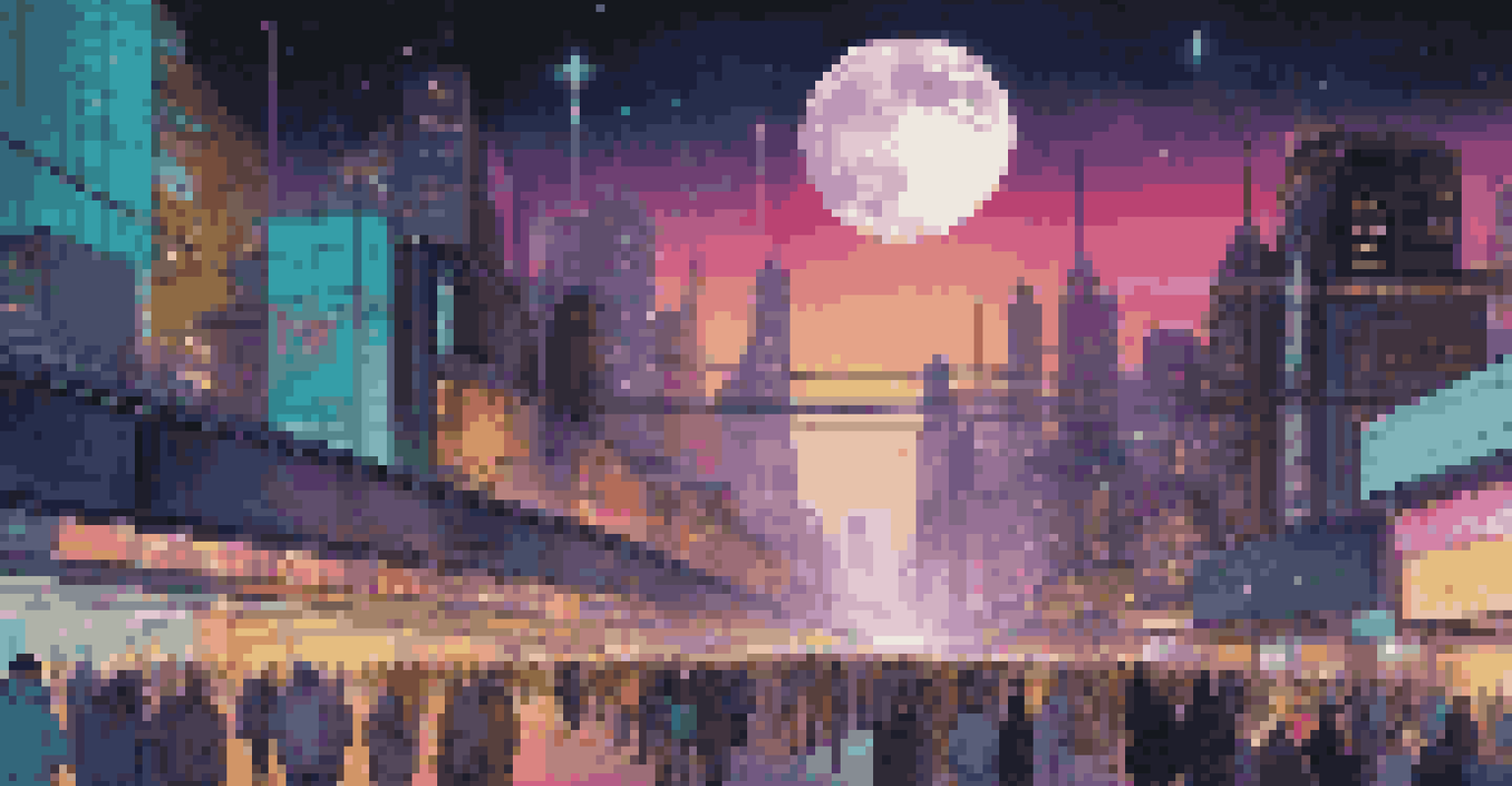The Influence of Popular Culture on Art Criticism Today

Understanding Art Criticism in Today’s Context
Art criticism has evolved significantly over the years, adapting to societal changes and cultural shifts. Today, it’s not just about evaluating artwork based on traditional standards; it's about understanding the broader context in which art is created and consumed. This evolution has opened the door for voices from diverse backgrounds, making art accessible to a wider audience.
Art enables us to find ourselves and lose ourselves at the same time.
In the past, critics often operated within an academic bubble, relying heavily on established norms and theories. However, with the rise of digital media and global communication, the barriers have lowered. Now, anyone with an internet connection can share their thoughts on art, which has democratized the criticism landscape and encouraged a more inclusive dialogue.
This shift highlights how art criticism is now influenced by popular culture, where trends and societal issues inform the conversation. As a result, critics are increasingly considering how art interacts with pop culture phenomena, making their evaluations more relevant to contemporary audiences.
The Role of Social Media in Art Criticism
Social media platforms like Instagram and Twitter have transformed how art is shared and discussed. Artists can showcase their work directly to audiences, bypassing traditional gallery spaces. This direct connection allows for immediate feedback and engagement, which can influence how critics perceive and discuss the art.

Critics now find themselves navigating a fast-paced environment where popular opinion can shift overnight. The viral nature of social media means that artworks can gain attention quickly, often driven by trends that reflect broader cultural conversations. This can sometimes overshadow more traditional forms of critique, leading to a blend of popularity and quality in assessment.
Art Criticism Embraces Inclusivity
Modern art criticism has evolved to include diverse voices and perspectives, moving beyond traditional academic standards.
Moreover, social media has birthed a new kind of art critic—the influencer, who often approaches criticism from a personal and relatable perspective. This democratization of critique means that diverse voices can emerge, bringing fresh insights that challenge conventional standards in the art world.
Influence of Celebrity Culture on Art Perception
Celebrity culture plays a significant role in shaping public perception of art today. When a celebrity endorses an artist or a specific work, it can propel that artwork into the limelight, influencing how critics and the public view its value. This phenomenon illustrates the power of fame in the art world, where popularity can sometimes overshadow artistic merit.
The role of the artist is to ask questions, not to answer them.
For instance, consider how artists like Banksy or Yayoi Kusama have gained international recognition not only for their art but also for their connections to celebrity culture. Their work often reflects social commentary that resonates with popular themes, making it more appealing to mainstream audiences and critics alike. This interplay between celebrity and art creates a unique dynamic in art criticism.
However, this relationship isn't without its drawbacks. Critics must navigate the tension between genuine artistic quality and the allure of celebrity, ensuring that their evaluations remain grounded in substance rather than popularity alone. This challenge underscores the complexity of modern art criticism in a culture heavily influenced by fame.
The Impact of Pop Culture Themes in Contemporary Art
Contemporary art increasingly draws from themes prevalent in popular culture, reflecting societal issues, trends, and narratives. Artists often incorporate elements from movies, music, and social movements, making their work relatable and timely. This fusion of art and pop culture creates a dialogue that resonates with audiences and invites critical examination.
For example, artists like Kehinde Wiley and Ai Weiwei address topics such as identity, race, and politics through lenses influenced by contemporary culture. Their work not only speaks to aesthetic considerations but also engages with pressing societal questions, prompting critics to explore deeper meanings. This connection enriches the art criticism landscape, encouraging a broader interpretation of art.
Social Media Transforms Art Dialogue
Platforms like Instagram and Twitter have reshaped how art is shared and critiqued, allowing for immediate feedback and a blend of popularity and quality.
As a result, critics are challenged to consider how these cultural references shape the viewer's experience. The interplay between art and pop culture themes creates opportunities for dialogue and exploration, prompting critics to recognize the significance of contemporary narratives in their evaluations.
The Blending of High and Low Culture in Art Criticism
The distinction between high art and low culture has blurred, leading to a more inclusive approach in art criticism. Influenced by popular culture, critics are now more open to evaluating works that may not fit traditional definitions of 'fine art.' This shift encourages a broader understanding of what constitutes valuable art, recognizing the merit in diverse forms of expression.
This blending is particularly evident in the rise of street art and digital art, which often draw from everyday experiences and popular themes. Critics are now acknowledging these forms as valid artistic expressions worthy of serious consideration. This change signifies a shift in the art world, where accessibility and relatability play crucial roles in evaluation.
As a result, art criticism embraces a wider range of influences, moving away from elitist perspectives. Critics are increasingly recognizing that art can emerge from any cultural context, enriching the conversation and reflecting a more democratic view of creativity.
Art Criticism and the Rise of the Digital Age
The digital age has revolutionized art criticism, offering new platforms for discussion and analysis. Online blogs, videos, and podcasts enable critics to reach global audiences, challenging traditional print media dominance. This shift encourages a more dynamic exchange of ideas and interpretations, fostering a vibrant community around art appreciation.
Moreover, the accessibility of digital platforms allows for a diversity of voices to emerge in art criticism. Individuals from varying backgrounds can share their perspectives, enriching the dialogue and challenging established norms. This democratization of art criticism reflects the broader societal changes influenced by digital communication.
Celebrity Culture Influences Art Value
The endorsement of artists by celebrities significantly impacts public perception and the value assigned to their work, complicating traditional evaluations.
Additionally, digital tools enable critics to engage with art in innovative ways. Virtual reality tours, interactive exhibitions, and social media discussions create immersive experiences that enhance understanding and appreciation of art. This evolution reshapes how critics analyze and evaluate artworks, making the process more engaging and inclusive.
The Future of Art Criticism in a Pop Culture Era
As popular culture continues to shape the art landscape, the future of art criticism will likely evolve in exciting ways. Critics may increasingly blend traditional analysis with pop culture references, creating a hybrid approach that resonates with contemporary audiences. This evolution can lead to a more engaging and relevant discourse around art.
Furthermore, the ongoing dialogue between artists and critics will play a crucial role in shaping future evaluations. As artists push boundaries and incorporate diverse influences, critics will need to adapt their methodologies to reflect these changes. This adaptability ensures that art criticism remains relevant in an ever-changing cultural landscape.

Ultimately, the influence of popular culture on art criticism today signifies a broader movement toward inclusivity and relevance. As the lines between art and culture continue to blur, critics will have ample opportunities to explore new dimensions of creativity, ensuring that the conversation remains vibrant and engaging.